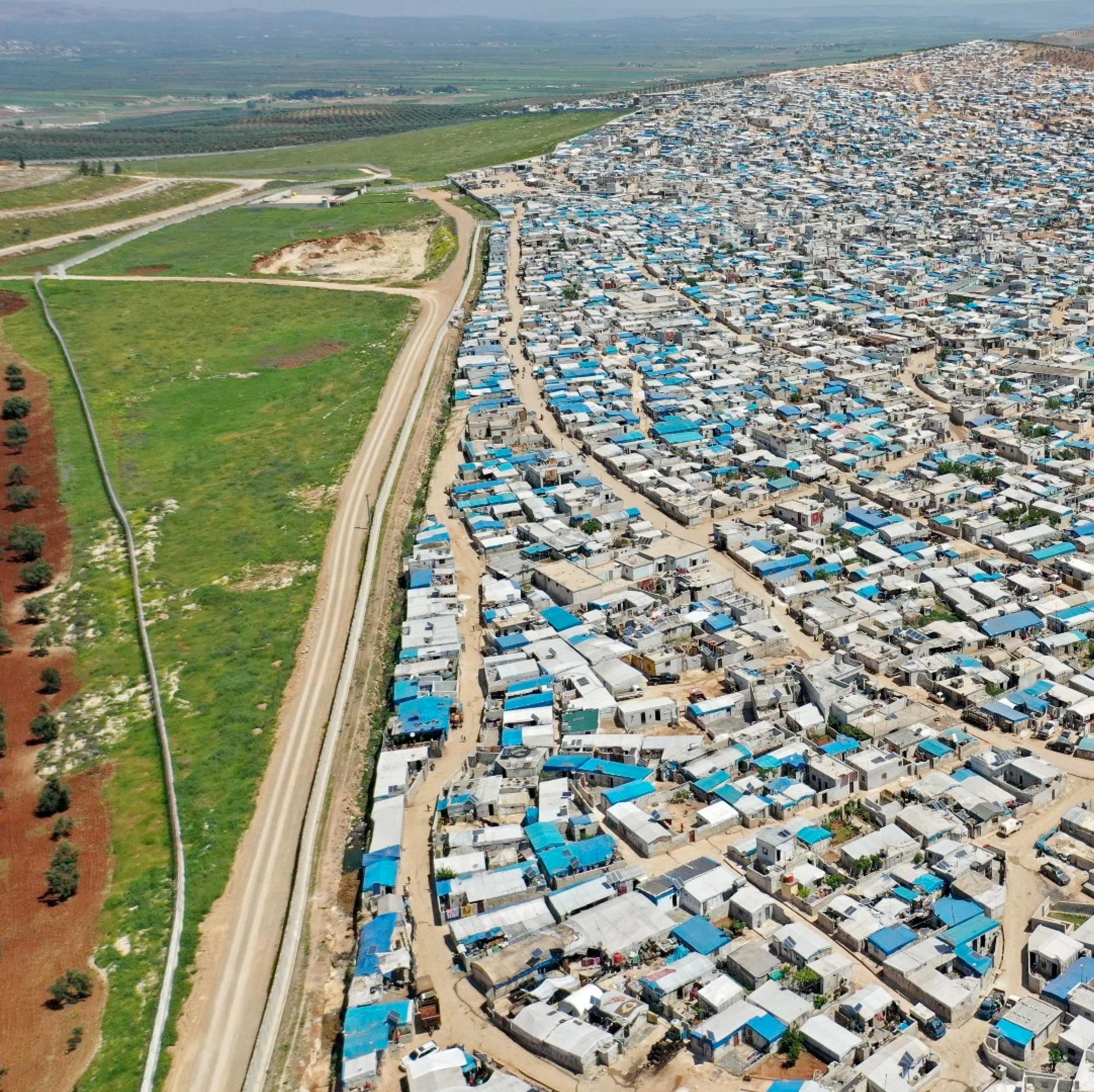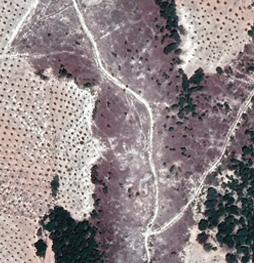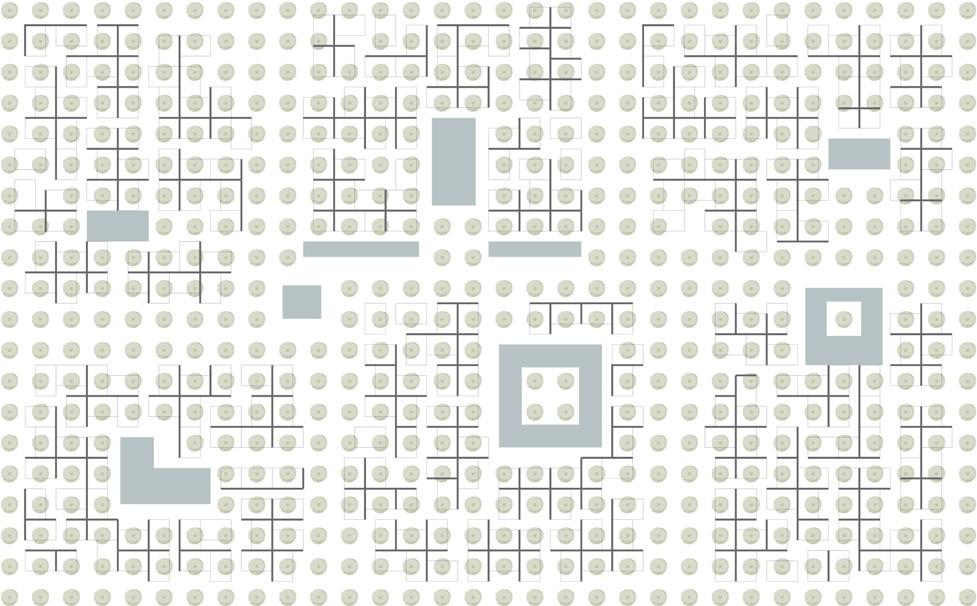A CASE STUDY TO RESETTLES REFUGEES IN NORTHERN SYRIA
A Master of Architecture Thesis by Dima











 Almeniawi
Almeniawi



Introduction
Endless journey of displacement

A tent is not a place to call home
Environmental challenges
Proposition and Methodology
THE CRISIS
The earthquake that struck Turkey and Northern Syria on February 6, 2023 came at a time where Syrian communities are pushed to the brink as the country marks its twelfth year of conflict on 15 March 2023.
It is estimated that 13 million Syrians have been forcibly displaced since the outbreak of the Syrian Revolution on March 15, 2011. That spring, Syrian people took to the streets in peaceful demonstrations demanding political reform, democracy, and basic human rights. The peaceful protests were met with a ruthless military response in the form of chemical weapons, explosives, and acts of violence that would later be categorized as war crimes.
For many Syrians, this is their twelfth year of living in displacement, marked by hostilities, poverty, and an uncertain future. The earthquakes only added to the layers of suffering, damaging homes and critical infrastructures.
In the aftermath of the 2023 earthquakes, Syrians found themselves once again building camps, but for a starkly different reason than normal. While the cause for displacement was a natural disaster instead of a man-made one, the result was the same—more people were left homeless, seeking safety and shelter while still enduring the trauma of loss.


 PEACEFUL PROTESTS WAR AFTERMATH DESTRUCTION EARTHQUAKE AFTERMATH DESTRUCTION
PEACEFUL PROTESTS WAR AFTERMATH DESTRUCTION EARTHQUAKE AFTERMATH DESTRUCTION

Introduction
Endless journey of displacement
A tent is not a place to call home

Environmental challenges
Proposition and Methodology
DISPLACEMENT
After twelve years of conflict, Syria remains home to one of the world’s largest refugee crises in recent history. More than 13 million Syrians have been forced to flee their homes since 2011. 6.8 million fled across the borders to neighboring countries, with more than 3.6 million Syrian refugees escaping to Turkey. About 851,000 Syrian refugees are in Lebanon, where they currently make up more than 14 percent of Lebanon’s population. 668,332 are in Jordan, 346,000 are in Iraq, and about 133,568 refugees are in Egypt.

+900,000 IDPs are living in tents
Of IDP live in tents
Of camps are self- reliant

6.7 Million people remain internally displaced, according to the Internal Displacement Monitoring Center (IDMC). Most of these refugees were forcibly relocated from cities and villages all across Syria to the Northern half of the country, towards Idlib and its suburbs, and across the border from Turkey. 2.5 million of the 6.7 million internally displaced Syrians; fled to the “Northern Syria Buffer Zone” established on the Syrian side of the Syria–Turkey border in August 2019 to maintain security along the border.
IDPS IN NORTHERN SYRIA

As more and more people around the world are forced to leave their homes, whether due to similar internal conflicts, the encroaching climate crisis, or other circumstances, the Syrian crisis brings up a pertinent line of questioning. How to address displacement within the broader context of ethics, politics, geography, and economy? Camps and shelters may be solutions we currently offer, but they are temporary and do not provide a sense of basic decency to their users.
23 percent of the total population in Northern Syria are currently living in camps. 69 percent of these camps are run and supported by an organization, and 31 percent are random, self-made camps where refugees rent private agricultural land and pay about one thousand dollars in annual rent to secure a space to set up their tents. There are no water or sanitary infrastructures in these types of camps. People have to walk long distances to relieve themselves in nature or to fetch potable water. Aid is offered only occasionally and residents are left to fend for themselves.
The outbreak of the global COVID-19 pandemic in 2020, as well as the Russian invasion of Ukraine in 2022 and the global economic crisis that followed it, are recent examples of global disasters that have also affected the camps in Syria. Higher prices for food and energy supplies, as well as donors faced with other crises, have made already terrible conditions in Northern Syria slide into a human catastrophe.
Despite the reality of camps increasingly becoming long-term dwellings for the displaced population, average life spent in camps is 27 years, humanitarian organizations continue to operate within an emergency management and crisis resolution framework. The state of impermanence in which the displaced population lives, stands in contrast to their continuous dependency on the support of humanitarian organizations for their daily survival.


Introduction
Endless journey of displacement
A tent is not a place to call home
Environmental challenges
Proposition and Methodology




A TENT IS NOT A PLACE TO CALL HOME

PRIVACY SNOW FLOODS
January, 2021 – A six-year-old boy has died and more than 20,000 children have been displaced by heavy flooding in North West Syria

*Save the Children

FIRE COLD
In January 2019, the UN said that 15 displaced Syrian children, 13 of them under one year old, had died due to cold weather and inadequate medical care



ENDLESS JOURNEY OF DISPLACEMENT
NO SHELTER
IDPs hosted by locals in their own homes, people started making tents out of canvas stretched between olive trees






SHELTER
TRANSITIONAL SHELTER




$ 400 24 m2
DURABLE SHELTER
$1,000 32 m2

 2020
2021
2020
2021









Introduction
Endless journey of displacement
A tent is not a place to call home

Environmental challenges
Proposition and Methodology
ENVIRONMENT AND FOOD SECURITY

Aug. 2017

Sept.. 2019


March 2022

THE ONE THOUSAND ROOM PROJECT TO RESETTLE
375 TREES CLEARED

RESETTLE 1,000 FAMILIES BY LOCAL NGO


OLIVE TREES CLEARED

OLIVE TREES ARE CLEARED TO BUILD TRANSITIONAL
472 UNITS BUILT

TRANSITIONAL HOUSING UNITS


200 OLIVE TREES CLEARED

MORE THAN 1,000 OLIVE TREES ARE CLEARED
MORE EXPANSION TO THE EAST AND WEST OF 472 UNITS BUILT

ON THIS SITE ONLY TO BUILD TWO THIS LOCATION 232 UNITS BUILT





Different materials and arrangements
Despite the different building materials and cluster arrangements that are currently offered to the displaced Syrians,


Syrians, none of it feels like a home



Introduction
Endless journey of displacement
A tent is not a place to call home
Environmental challenges
Proposition and Methodology

THE PROPOSAL
In Northern Syria, every year, for 12 years now, an average of $100,000,000 is spent on disposable shelter material. Rather than spending aid money year after year on renewing tarps and canvas for tents, a more sustainable approach would be to invest in campground infrastructure to enable future development, which could leverage informal, bottom-up urbanization that emerges in the absence of formal authority. This would lay the groundwork for community-led, small-scale urban development that can democratize cities and transform their neighborhoods.
Residents of camps have been marginalized as a result of a dependency on external aid and the unchanging status quo, and they are trapped in space while time passes them by. Although they could be a great asset and part of the solution, the Syrian people have been relegated to a stationary status, a problem that must be dealt with. In order to change this reality, displaced people’s must take a stand for themselves and reclaim the right to determine their own future, instead of waiting to be rescued. This requires a change in perspective on the part of humanitarian agencies, a shift from viewing camp residents as helpless victims to recognizing them as resilient survivors who demonstrate remarkable strength and dignity in the face of extreme circumstances.
When given the tools, these people are capable of rebuilding their lives both physically and metaphorically, to create a future that is no longer imaginary, nor temporary.
DESIGN PRINCIPLES

This transformation is intended to happen in phases:
Phase I: Redesigning camp layouts to promote a sense of community and comfort.
Phase II: Establishing basic shared structural elements that camp residents can employ to frame their urban growth in an organized pattern, and transition their temporary accommodations into more permanent structures.
Phase III: Transforming the lives of camp residents who are now able to rebuild their homes and their dreams for a better future.
COURTYARD HOUSES, THE BUILDING BLOCKS
SINGLE
CELL HOUSE Vs 9-SQUARE SYRIAN HOUSE
A CLOSELY KNITTED COMMUNITY
NGOs APPROACH TO SHELTER REFUGEES Vs
100 families
24m2 per family
16% footprint
140 families
32m2 per family
31% footprint
100 trees
14,400
Vs PATH TO PERMANENCY PROPOSAL
HOW TO BUILD THE NUBIAN VAULT



SUPPORTING WALL
SUPPORTING BEAMS
DRAWING THE VAULT WITH STRINGS
PLACE THE BRICKS IN ORDER TO FORM A 70 ° ANGLE WITH THE BASELINE OF THE VAULT. THE FIRST BRICK WILL REST DIRECTLY ON SUPPORTING WALL



PLACE IN SUCCESSION THE OTHER BRICKS TO DEFINE THE FIRST ARC
LAY TH BITUMINOUS MEMBRANE AND THEN COVER WITH EXTERIOR PLASTERING OVER THE NUBIAN VOLT CLAY AND CEMENT (10 CM)
SUPPORT & INFILL MATRIX

RESIDENTIAL AGGREGATIONS MATRIX

PLANNING WITH FUTURE DEVELOPMENT


INCREMENTAL TRANSFORMATION OF A CAMPGROUND TO A NEIGHBORHOOD
REDESIGNING



MOVING IN WITH TEMPORARY SHELTER
INCREMENTAL TRANSFORMATION PERMANENT
BUILD SHARED SUPPORTING ELEMENTS ALLOCATE LOTS


Phase I
REDESIGNING CAMP LAYOUTS TO PROMOTE A SENSE OF COMMUNITY AND COMFORT

TRANSFORMATION FROM TEMPORARY TO COMMUNITY FULLY DEVELOPED. CIRCULATION PATHS FILTER TRAFFIC BETWEEN PUBLIC AND PRIVATE SPACES


INCREMENTAL TRANSFORMATION OF A TEMPORARY




EXISTING SITE IS ON AN OLIVE GROVE LAYING DRAINAGE AND SEWAGE INFRASTRUCTURE
LAYING FOOTING AND FOUNDATION FOR SHARED STRUCTURE
ESTABLISHING BASIC SHARED STRUCTURAL AN ORGANIZED PATTERN, AND TRANSITION




CAMP IS NOW READY TO HOST FAMILIES IN TEMPORARY SHELTER
CAMP RESIDENTS EXPAND THEIR LIVING SPACE PER EXISTING FOUNDATION
CAMP RESIDENTS BEGIN PORARY ENCLOSURE PERMANENT ONES
TRANSFORMING THE LIVES OF CAMP
TEMPORARY SHELTER INTO A PERMANENT HOME
FOUNDATION IS LAID TO FRAME FUTURE EXPANSION AND PROTECT AGAINST OVERCROWDING AND TURNING CAMP SITE TO SLUMS
PHASE II
BUILDING PERMANENT SUPPORTING STRUCTURES OF DIFFERENT SCALES AND FROM LOCAL BUILDING MATERIALS
STRUCTURAL ELEMENTS THAT CAMP RESIDENTS CAN EMPLOY TO FRAME THEIR URBAN GROWTH IN TRANSITION THEIR TEMPORARY ACCOMMODATIONS INTO MORE PERMANENT STRUCTURES.



SLABS OF LOCAL MATERIALS ARE LAID AT MINIMUM SPACE TO ACCOMMODATE TEMPORARY SHELTER
BEGIN REPLACING TEMMATERIALS WITH







CAMP RESIDENTS HAVE FINALLY TRANSFORMED THEIR TEMPORARY SHELTER INTO A PERMANENT HOME
PHASE III
HOMES CAN EXPAND VERTICALLY AND ADAPT TO FAMILY’S CHANGING NEEDS
CAMP RESIDENTS WHO ARE NOW ABLE TO REBUILD THEIR HOMES AND COMMUNITY








